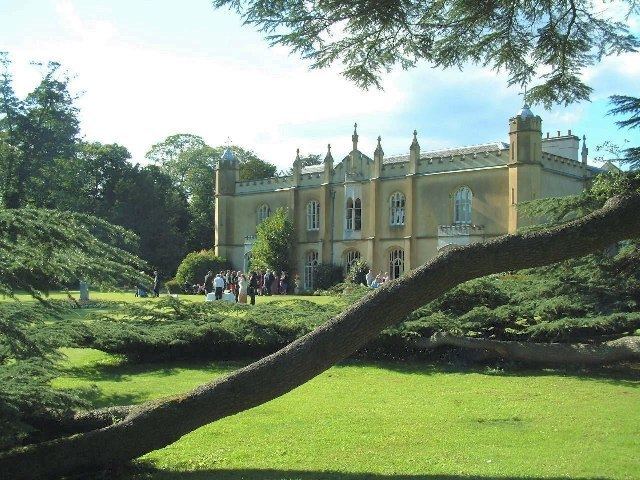Established 1133 Founder(s) William de Missenden | Disestablished 1538 | |
 | ||
Order Arrouasian (Augustinian) | ||
Missenden Abbey (also referred to as Great Missenden Abbey) was a former Arrouasian (Augustinian) monastery, founded in 1133 in Great Missenden, Buckinghamshire, United Kingdom. The abbey was dissolved in 1538, and the abbey church demolished. In 1574 a house, also known as Missenden Abbey, was constructed on the site of the monastic cloisters, incorporating some of the monastic remains. The house was altered several times, gaining its current "Regency Gothic" style at the beginning of the 19th-century. The house was "gutted" by fire in 1985 and subsequently rebuilt.
Contents
Foundation
The abbey of Missenden was founded c.1133, by William de Missenden, the lord of Missenden manor. Two of the abbey's foundation charters (those issued by King Henry I, and by Alexander, Bishop of Lincoln) state there were originally seven canons, who came to Missenden from "the church of St. Mary 'de Bosco (or de Nemore) de pago Terresino". This church - thought to have been in Ruisseauville, France - was a daughter house of Arrouaise Abbey, also in France. Missenden thus became the home of the first abbey in Buckinghamshire and the second Arrouasian community in England, after Warter Abbey in East Yorkshire.
"The Arrouasian canons differed very little from other Augustinians, and sometimes abandoned at an early date the slight distinctions they originally had". The Arrouasian Order "never seem to have been really an independent order with special privileges", and thus often were not distinguished from canons of the Augustinian Order.
15th and 16th Centuries
During a visit conducted between 1431 and 1436, William Grey, Bishop of Lincoln, found that the abbey did not have enough canons to perform its religious duties, and that some of the abbey's buildings were in need of repair.
A visit in 1518 by William Atwater, Bishop of Lincoln, found the discipline at the abbey was "lax", and that the refectory needed to be repaired. In 1521, a canon at the abbey was forced to do penance for heresy.
In 1530 and 1531 the abbey was visited by John Longland, Bishop of Lincoln, who found the abbey in debt, while all of the buildings were in need of repair. The bishop found the abbot, John Fox, to be " wholly under the influence of a secular, John Compton, who cut down trees and did as he pleased with the goods of the monastery." Bishop Longland suspended Abbot Fox, placing the abbey under the control of John Otwell, who would later become abbot himself.
Dissolution
The abbey was surrendered for dissolution in 1538, and the abbey church was demolished the same year. The last abbot, John Otwell, subsequently married before dying in 1552.
Architectural history and remains
There is no extant plan of the medieval monastery, but a partial reconstruction is possible based on documentary evidence, excavation work and comparisons with other religious houses of the period. The Abbey Church, which was dedicated to the Blessed Virgin Mary, was located on the North side of the cloister, running from west to east, as was typical of the period. Excavated stonework suggests that the church was highly decorated, in a romanesque style. The church housed the largest bell in Buckinghamshire, which weighed more than 2.5 tons.
The abbey church, of which nothing remains, was located 300yds east of the present building. This building incorporates stonework from the east range of the cloister buildings, but none of it is visible. Excavations conducted in 1983 showed that the abbey church was built in two or three phases; the earliest of which dated from the mid-12th-century.
Abbots of Missenden
A list of the known abbots of Missenden:
Burials at the Abbey
Construction
Like many other former monasteries, a country house was constructed on the site o the former abbey. Also known as "Missenden Abbey", the house was constructed in 1574, on the site of the former cloisters, and incorporating some of the monastic remains. The house was altered and remodeled in both the 17th and 18th centuries. Between 1806 and 1814, the house was remodlled in a "Regency Gothic" style, for John Ayton. The two storied house was built around a courtyard and featured "castellated parapets, corner turrets with arrow slits and conical caps."
Fire and later history
The building was designated Grade II listed on 10 March 1983. However, in 1985 the building was destroyed by fire. The house was "gutted". Among that destroyed was the "15th or 16th century roof of the East range", which was "a rare survival of a monastic roof". The building was reconstructed following the fire, with some of the interiors remodeled.
The abbey has been owned by Buckinghamshire New University since the mid-1990s. It is now used as a conference centre and also used for weddings.
In April 2016, the abbey's first same-sex marriage was performed.
